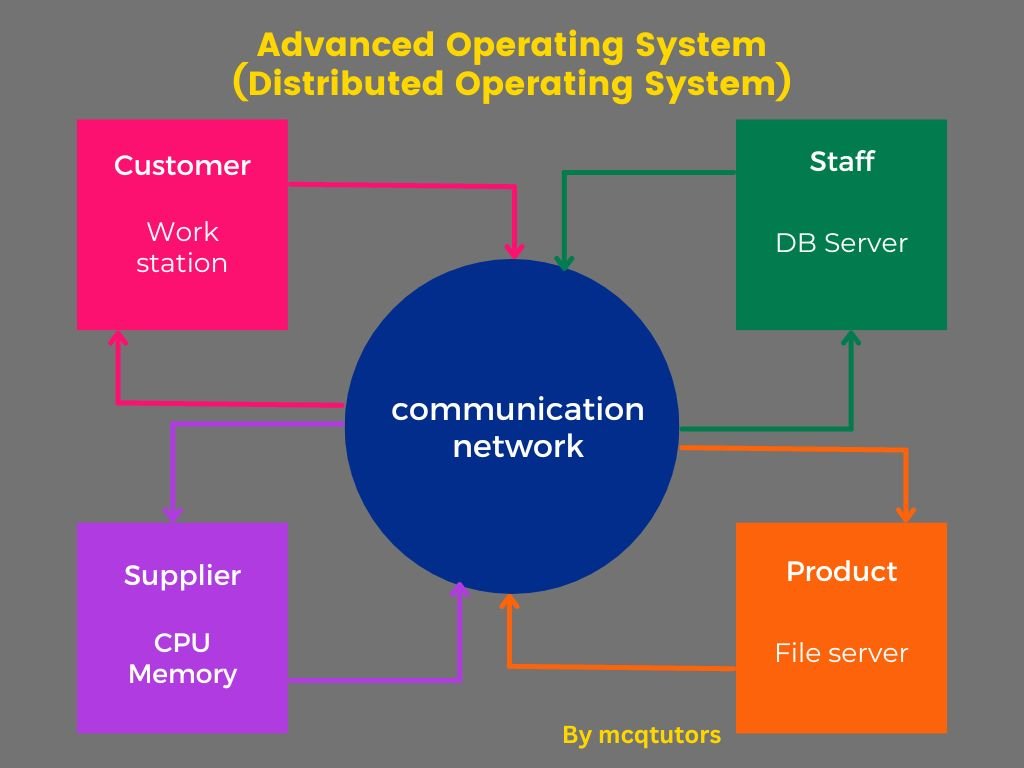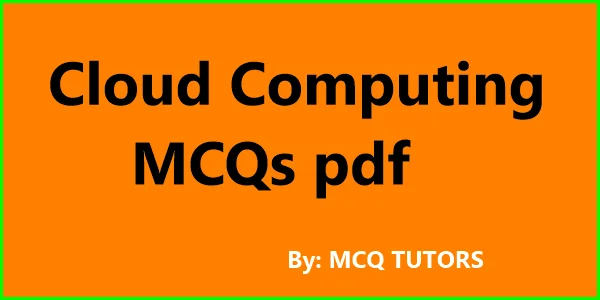Advanced Operating System (Distributed Operating System)
With the ever-growing complexity of the modern computing environment, advanced operating systems are becoming increasingly important.
An advanced operating system, or distributed operating system, is a special type of computer software designed to manage hardware and software resources of a computer network.
These systems provide users with an efficient and reliable platform for managing both local and remote resources.
Distributed operating systems offer significant advantages over traditional single-systems, such as improved scalability, fault tolerance, and resource efficiency.

46 Advanced Operating System (Distributed Operating System) with answer in pdf
1. The basic functions of an operating system are
a) Controls and coordinates the use of the hardware
b) Acts as resource allocate and manager
c) Controls the user programs to prevent errors and improper use of the computer
d) All of the above
Ans. d
2. Paging is solution to
a) External fragmentation problem
b) Internal fragmentation
c) Both a & b
d) None of the above
Ans. a
3. While running DOS on a PC, which command would be used to duplicate the entire diskette
a) Diskcopy
b) Cp
c) cmd
d) mv
Ans. a
4. The benefit of code sharing is that
a) It allows inter process communication
b) It allows an application to have several different threads of activity all within the same address space.
c) Reusability
d) Modularity
Ans. b
5. __ is a hardware technique where the system appears to have more memory that it actually does
a) Paging
b) Semaphore
c) Virtual memory
d) Fragmentation
Ans. c
6. The term used to calculate number of processes that complete their execution per time unit is
a) Turnaround time
b) Response time
c) Waiting time
d) Throughput
Ans. d
7. The term used to calculate the amount of time to execute a particular process.
a) Turnaround time
b) Response time
c) Waiting time
d) Throughput
Ans. a
8. The term used to calculate the amount of time a process has been waiting in the ready queue
a) Turnaround time
b) Response time
c) Waiting time
d) Throughput
Ans.
9. The term used to calculate the amount of time it takes from when a request was submitted until the first response is produced, not output (for time-sharing environment).
a) Turnaround time
b) Response time
c) Waiting time
d) Throughput
Ans. b
10. What is the state of the processor, when a process is waiting for some event to occur?
a) Waiting state
b) Ready state
c) Running state
d) Suspended state
Ans. a
11. A real time operating system has
a) Variable time constraints
b) Well defined fixed time constraints
c) The defined constraints
d) None of the above
Ans. b
12. The properties of Hard real-time operating system are
a) Secondary storage limited or absent
b) Data stored in short term memory, or read-only memory (ROM)
c) Conflicts with time-sharing systems not supported by general-purpose operating systems
d) All of the above
Ans. d
13. The properties of Soft real-time operating system are
a) Limited utility in industrial control of robotics
b) Useful in applications (multimedia, virtual reality) requiring advanced operating-system features.
c) Both a & b
d) None of the above
Ans. c
14. __ is caused by under allocation of the minimum number of pages required by a process, forcing it to continuously page fault.
a) Thrashing
b) Throughput
c) Threading
d) None of the above
Ans. a
15. The technique of running several programs at a time using timesharing. It allows a computer to do several things at the same time is known as
a) Multithreading
b) Multiprogramming
c) Multi tasking
d) All of the above
Ans.b
16. The function of Multiprogramming is
a) Creates logical parallelism.
b) To keep several jobs in memory simultaneously
c) To keep CPU busy all the time.
d) All of the above
Ans. d
17. In__ the switching between jobs occurs so frequently that the users can interact with each program while it is running.
a) Programming
b) Paging
c) Multi tasking
d) Multi threading
Ans. c
18. __ occurs in a dynamic memory allocation system when many of the free blocks are too small to satisfy any request.
a) Fragmentation
b) Segmentation
c) Virtual memory
d) Page fault
Ans. a
19. _ happens when a dynamic memory allocation algorithm allocates some memory and a small piece is left over that cannot be effectively used.
a) Fragmentation
b) Segmentation
c) External Fragmentation
d) Internal Fragmentation
Ans. c
20. is the space wasted inside of allocated memory blocks because of restriction on the allowed sizes of allocated blocks.
a) Internal fragmentation
b) Fragmentation
c) Segmentation
d) External Fragmentation
Ans. a
21. The module gives control of the CPU to the process selected by the short-term scheduler
a) Scheduler
b) Dispatcher
c) Compiler
d) Interpreter
Ans. b
22. The functions of a dispatcher are
a) Switching context
b) Switching to user mode
c) Jumping to the proper location in the user program to restart that program, dispatch latency – time it takes for the dispatcher to stop one process and start another running.
d) All of the above
Ans. d
23. _ Selects from among the processes in memory that are ready to execute, and allocates the CPU to one of them.
a) Dispatcher
b) Pager
c) Scheduler
d) None of the above
Ans. c
24. Switching the CPU to another process requires saving the state of the old process and loading the saved state for the new process. This task is known as a
a) Context-switch
b) Scheduler
c) Translator
d) None of the above
Ans. a
25. The memory that a computer microprocessor can access more quickly than it can access regular RAM is called
a) DRAM
b) SRAM
c) Cache memory
d) Registers
Ans. c
26. When a process requests an available resource, system must decide if immediate allocation leaves the system in a __ state.
a) Ready
b) Running
c) Deadlock
d) Safe
Ans. d
27. A process may be defined as:
a) A set of instructions to be executed by a computer.
b) b. A program in execution.
c) A piece of hardware that executes a set of instructions.
d) The main procedure of a program.
Ans. b
28. A processor in the context of computing is:
a) A set of instructions to be executed on a computer.
b) A program in execution.
c) A piece of hardware that executes a set of instructions.
d) The main procedure of a program.
Ans. c
29. A multiprogramming system may be defined as one in which:
a) Programs are divided into pages.
b) Input is accepted in batches of many jobs.
c) Several programs can reside in memory at the same time.
d) Many processes may share the same program residing in main memory.
Ans.c
30. The main distinction between a multiprocessor system and a multiprogrammed system is that in a multiprocessor system:
a) Several programs share the main storage.
b) The input is accepted in batches of many jobs.
c) Processor time is shared among several processes.
d) Many processors may be active simultaneously.
Ans. d
31. A counting semaphore was initialized to 9. Then 27 P (wait) operations and 23 V (signal) operations were completed on this semaphore. The resulting value of the semaphore is:
a) 5
b) 0
c) 7
d) 13
Ans. a
32. The main difference between binary semaphores and counting semaphores is that:
a) Binary semaphores can only take the values 0 and 1, while counting semaphores can take any non-negative integer values.
b) Binary semaphores can only be used to solve problems involving up to two processes sharing the same resource, while counting semaphores can be used to solve problems involving more than two processes sharing the same resource.
c) Binary semaphores cannot solve all the problems that can be solved by counting semaphores.
d) Counting semaphores must be controlled by a monitor, while binary semaphores are called directly by user processes.
Ans. a
33. A wait operation on a semaphore should not occur within a critical section controlled by that semaphore because:
a) A deadlock will occur.
b) A semaphore is not a shared variable.
c) Another process may then enter the critical section violating the mutual exclusion constraint.
d) A signal on a semaphore is always given from outside the critical section.
Ans. a
34. Which of the following statements is false?
a) Disjoint processes need not use critical sections.
b) Programs with critical sections can never be used simultaneously by more than one process.
c) A process wanting to enter a critical section currently in use must wait for the process utilizing the critical section to terminate.
d) Two different critical sections may be executed concurrently if they do not use the same shared variables.
Ans. b
35. The basic principle of a monitor is that:
a) Several resources can only be controlled by a monitor.
b) Several processes may concurrently execute a procedure of a given monitor.
c) Only one process may execute a procedure of a given monitor at any given time.
d) It schedules the execution of processes in a multiprocessor operating System.
Ans. c
36. Which of the following actions may result in a process becoming blocked?
a) A process executes a P (wait) operation on a semaphore.
b) A process executes a V (signal) operation on a semaphore.
c) A process exits from a critical section.
d) A process within a critical section changes the value of a shared variable.
Ans. a
37. Non-preemptive-process-scheduling policies:
a) Are indispensable for interactive systems.
b) Allocate the processor to a process for a fixed time period.
c) Always use a ready queue sorted in order of decreasing priority.
d) Make short jobs wait for long jobs.
Ans. d
38. The pure-round-robin-scheduling policy:
a) Responds poorly to short processes if the time slice is small.
b) Does not use any a priori information about the service times of processes.
c) Becomes equivalent to the Shortest-Job-First Policy when the time slice is made infinitely large.
d) Ensures that the ready queue is always the same size.
Ans. b
39. The code stored in ROM that is able to locate the kernel, load it into memory, and start its execution is called
a.) Loader
b.) Linker
c.) Compiler
d.) Boot strap program
Ans. d
40. Multiprogramming is the technique
a.) Of running several programs at a time using timesharing.
b.) It allows a computer to do several things at the same time.
c.) It creates logical parallelism
d.) All of the above
Ans. d
41. occurs in a dynamic memory allocation system when many of the free blocks are too small to satisfy any request
a.) Fragmentation
b.) Segmentation
c.) Paging
d.) Demand paging
Ans. a
42. The space wasted inside of allocated memory blocks because of restriction on the allowed sizes of allocated blocks is known as
a.) External fragmentation
b.) Internal fragmentation
c.) Both a & b
d.) None of the above
Ans. b
43. The task of a dispatcher is/are
a.) Switching context
b.) Switching to user mode
c.) Jumping to the proper location in the user program to restart that program
d.) All of the above
Ans. d
44. The time taken by the dispatcher to stop one process and start another running is called
a.) Latency time
b.) Time delay
c.) Dispatch latency
d.) None of the above
Ans. c
45. Switching the CPU to another process requires saving the state of the old process and loading the saved state for the new process. This task is known as
a.) Context switch
b.) Switching
c.) Dispatching
d.) Scheduling
Ans. a
46. is random access memory (RAM) that a computer microprocessor can access more quickly than it can access regular RAM.
a.) Registers
b.) Cache memory
c.) Virtual memory
d.) Buffer
Ans. b
Conclusion:
Distributed operating systems can provide a variety of benefits to businesses. It is likely to become more prevalent as technology advances and business needs increase.
This type of system offers increased scalability and the ability to access data from multiple devices. It also allows for greater security, improved performance and reliability, and better resource utilization.
Organizations that are looking for a cost-effective solution for their computing needs should consider implementing a distributed OS.
Read more:



